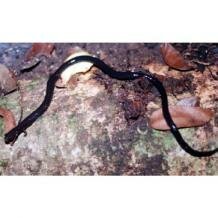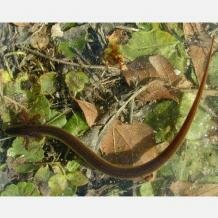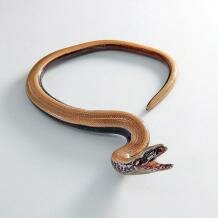Topic: Worm-like body form
Man is but a worm, but so are many other vertebrates...
The worm-like form has evolved repeatedly in the animals, and for the most part is so generalised as to mean little more than a soft-bodied creature, often capable of marked contraction. In the context of evolutionary convergence, however, there are some very striking and specific examples.
 Early tetrapods
Early tetrapods
A worm-like body form was already evident in some extinct tetrapods. For example, the Aïstopoda were a group of limbless tetrapods that lived in Europe and North America in the Carboniferous and Early Permian. They closely resembled snakes and had extremely elongated bodies with up to 200 vertebrae. The similarities with snakes include skull morphology – in advanced aïstopods, as well as in snakes, the braincase is supported against the lower jaw by a series of struts.  The lifestyle of aïstopods has been subject to much speculation. Whilst they are commonly assumed to be aquatic or fossorial, it has recently been suggested that they were in fact terrestrial and moved through lateral undulation. In contrast, the taxonomically enigmatic stem tetrapod Crassigyrinus scoticus from the Early Carboniferous was almost certainly aquatic. This large, long-bodied predator was not completely limbless but had greatly reduced forelimbs. So no convergence? On the contrary – it might have shown behavioural similarities to moray eels.
The lifestyle of aïstopods has been subject to much speculation. Whilst they are commonly assumed to be aquatic or fossorial, it has recently been suggested that they were in fact terrestrial and moved through lateral undulation. In contrast, the taxonomically enigmatic stem tetrapod Crassigyrinus scoticus from the Early Carboniferous was almost certainly aquatic. This large, long-bodied predator was not completely limbless but had greatly reduced forelimbs. So no convergence? On the contrary – it might have shown behavioural similarities to moray eels.
Amphibians
Caecilians
 The caecilians provide a particularly celebrated instance of convergence. Some taxa, notably Dermophis, are remarkably convergent on annelids such as the earthworm. In other words, a vertebrate has managed to translate itself into a worm. The crucial transition lies in the development of a hydrostatic skeleton and an almost complete detachment between the vertebral column and the outer skin and muscle. Kinematic analysis reveals that during locomotion the spine is thrown into curves (as in a snake), but as it is decoupled from the outer skin and muscle, the latter moves independently and provides successive points of contact in a way very similar to that seen in the progression of the earthworm. In addition to this decoupling, there is an array of tendons that form a crossed helix. This extraordinary morphology is an adaptation to the burrowing habit of these amphibians.
The caecilians provide a particularly celebrated instance of convergence. Some taxa, notably Dermophis, are remarkably convergent on annelids such as the earthworm. In other words, a vertebrate has managed to translate itself into a worm. The crucial transition lies in the development of a hydrostatic skeleton and an almost complete detachment between the vertebral column and the outer skin and muscle. Kinematic analysis reveals that during locomotion the spine is thrown into curves (as in a snake), but as it is decoupled from the outer skin and muscle, the latter moves independently and provides successive points of contact in a way very similar to that seen in the progression of the earthworm. In addition to this decoupling, there is an array of tendons that form a crossed helix. This extraordinary morphology is an adaptation to the burrowing habit of these amphibians.
 Salamanders
Salamanders
Within the Plethodontidae, a large family of lungless salamanders, an elongated body form has evolved independently at least twice in different fossorial groups. The ‘worm salamanders’ in the genus Oedipina from Mexico and Ecuador, Batrachoseps from California and the Mexican genus Lineatriton show very similar morphology, being extraordinarily slender with only tiny limbs.  However, while Oedipina and Batrachoseps have become elongate by adding more trunk vertebrae (comparable to eels), Lineatriton has achieved elongation in a very different way. Here, individual trunk vertebrae have become longer, just as in giraffes. Some aquatic salamanders have also come to resemble worms. One example is the olm (Proteus anguinus), a blind salamander that lives in the subterranean waters of karst caves in Central and Southeastern Europe. Olms have a long, snake-like body with small limbs with fewer digits, probably to facilitate swimming, which is achieved by a twisting of the body. Members of the unusual salamander family Sirenidae from the USA and Mexico have tiny forelimbs, completely lack hind limbs and their eel-like body can reach almost a metre in length.
However, while Oedipina and Batrachoseps have become elongate by adding more trunk vertebrae (comparable to eels), Lineatriton has achieved elongation in a very different way. Here, individual trunk vertebrae have become longer, just as in giraffes. Some aquatic salamanders have also come to resemble worms. One example is the olm (Proteus anguinus), a blind salamander that lives in the subterranean waters of karst caves in Central and Southeastern Europe. Olms have a long, snake-like body with small limbs with fewer digits, probably to facilitate swimming, which is achieved by a twisting of the body. Members of the unusual salamander family Sirenidae from the USA and Mexico have tiny forelimbs, completely lack hind limbs and their eel-like body can reach almost a metre in length.
Reptiles
In the reptiles, a worm-like body has evolved multiple times, often in adaptation to burrowing. Here are some examples.
 Burrowing skinks
Burrowing skinks
The so-called ‘burrowing skinks’ in the family Scincidae are highly specialised fossorial lizards that display a progression of limb loss (e.g. among Scelotes species of Southern Africa), with some entirely limbless, worm-like species (e.g. the Western burrowing skink Typhlacontias of Southern Africa, and Janetascincus and Pamelascincus that are endemic to the Seychelles). Burrowing skinks have a flattened snout like other sand-dwelling lizards, smooth overlapping scales for efficient movement and tend to lack eyes, eyelids and external ear openings.
Anguids
In the widely distributed lizard family Anguidae, which contains the so-called ‘slow worms’ and ‘glass snakes’, body elongation and limb loss have occurred multiple times. There are more than 100 species in 15 genera and four subfamilies, three of which contain snake-like limbless members. Body elongation is correlated with limb loss, which in turn goes hand in hand (so to speak) with a reduction in digit number (and there is evidence that these variables all gradually change together rather than one after the other). Although many anguids are fossorial, there is no consistent association between limb loss and burrowing in this group. Similar to the situation in the plethodontid salamanders, an elongation of the body can be achieved in two ways – elongation of only the trunk (e.g. in Anniella) and elongation of trunk and tail (e.g. in Ophiodes). So there seem to be two different ecomorphs that have evolved independently several times – small burrowers with a short tail and large, long-tailed forms that “swim” through the grass. This dichotomy is probably widespread among snake-like lizards.
There are more than 100 species in 15 genera and four subfamilies, three of which contain snake-like limbless members. Body elongation is correlated with limb loss, which in turn goes hand in hand (so to speak) with a reduction in digit number (and there is evidence that these variables all gradually change together rather than one after the other). Although many anguids are fossorial, there is no consistent association between limb loss and burrowing in this group. Similar to the situation in the plethodontid salamanders, an elongation of the body can be achieved in two ways – elongation of only the trunk (e.g. in Anniella) and elongation of trunk and tail (e.g. in Ophiodes). So there seem to be two different ecomorphs that have evolved independently several times – small burrowers with a short tail and large, long-tailed forms that “swim” through the grass. This dichotomy is probably widespread among snake-like lizards.
Amphisbaenians
Astonishingly annelid-like are the aptly named ‘worm-lizards’ (Amphisbaenia), a group of scaled reptiles (squamates) that is distinct from true lizards or snakes and contains more than 130 tiny, carnivorous species. Here, adaptations to an underground existence, such as an elongate body and limb loss, seem to have evolved several times. Examples include the limbless, shovel-headed Rhineura floridana, the keel-headed Anops kingii and the Mexican species Bipes bioporus, which has tiny forelimbs. The highly derived amphisbaenians are not that well understood, but recent molecular evidence has suggested that they are closely related to lacertid lizards and separate from snakes and other limbless squamates, with which they share several morphological characteristics.
Cite this web page
Map of Life - "Worm-like body form"
https://mapoflife.org/topics/topic_54_worm-like-body-form/
November 29, 2020


